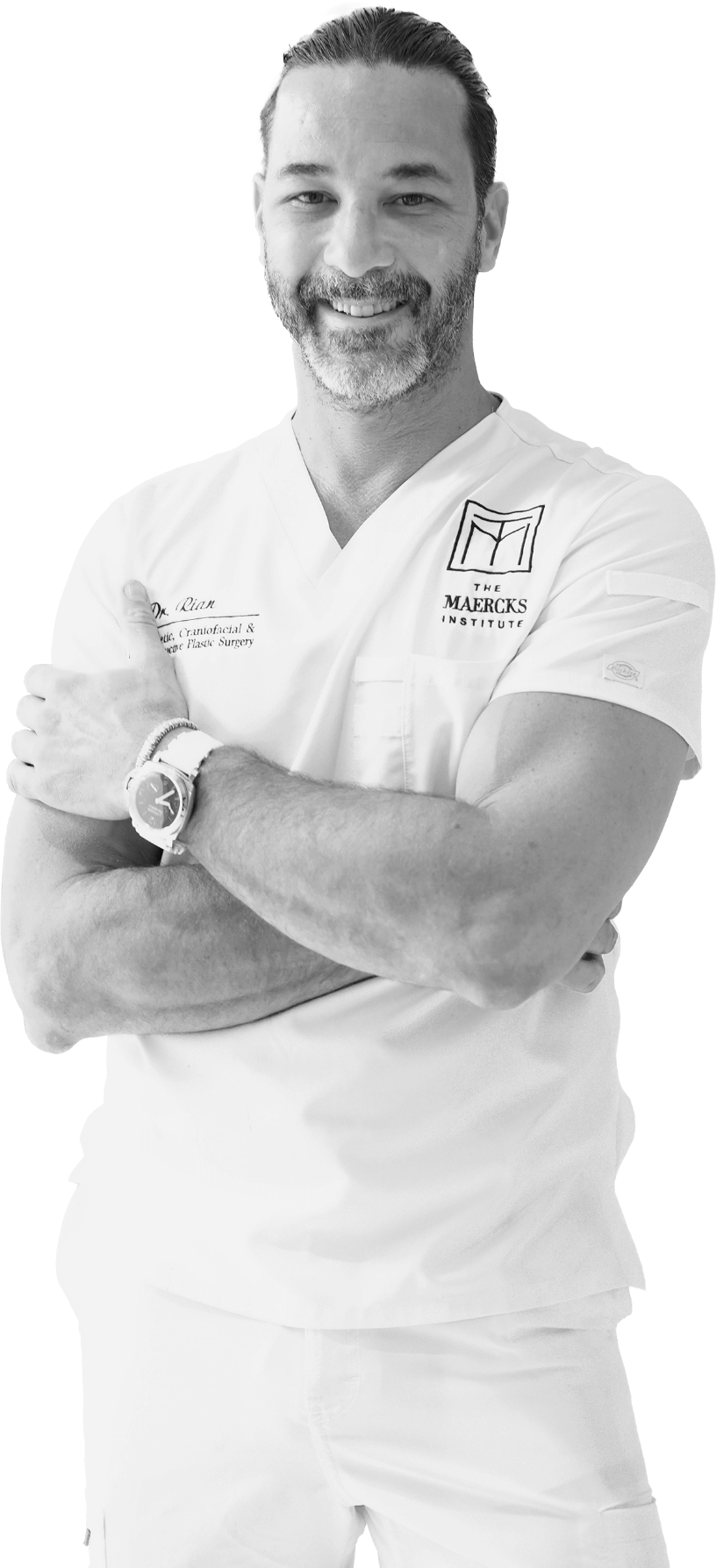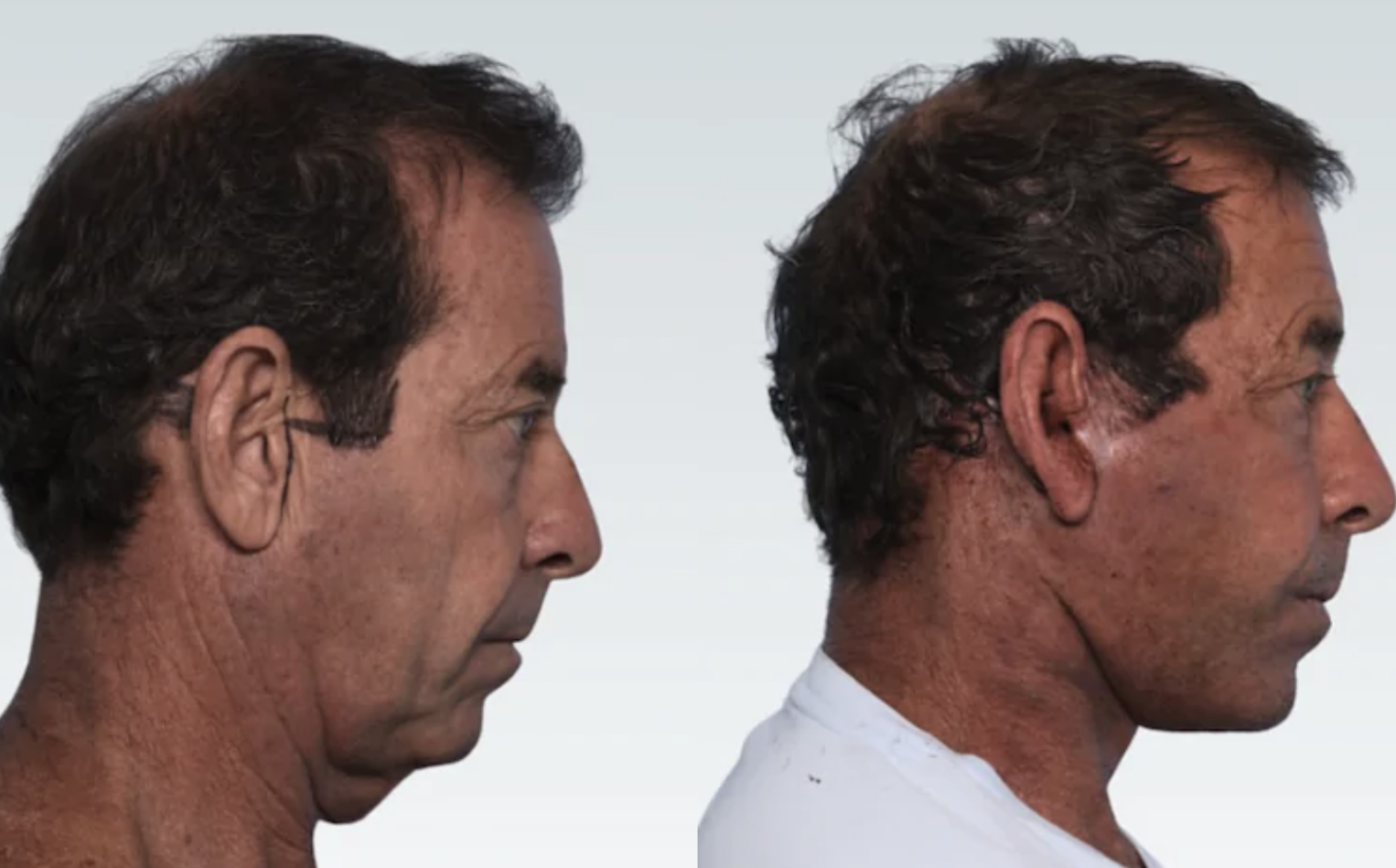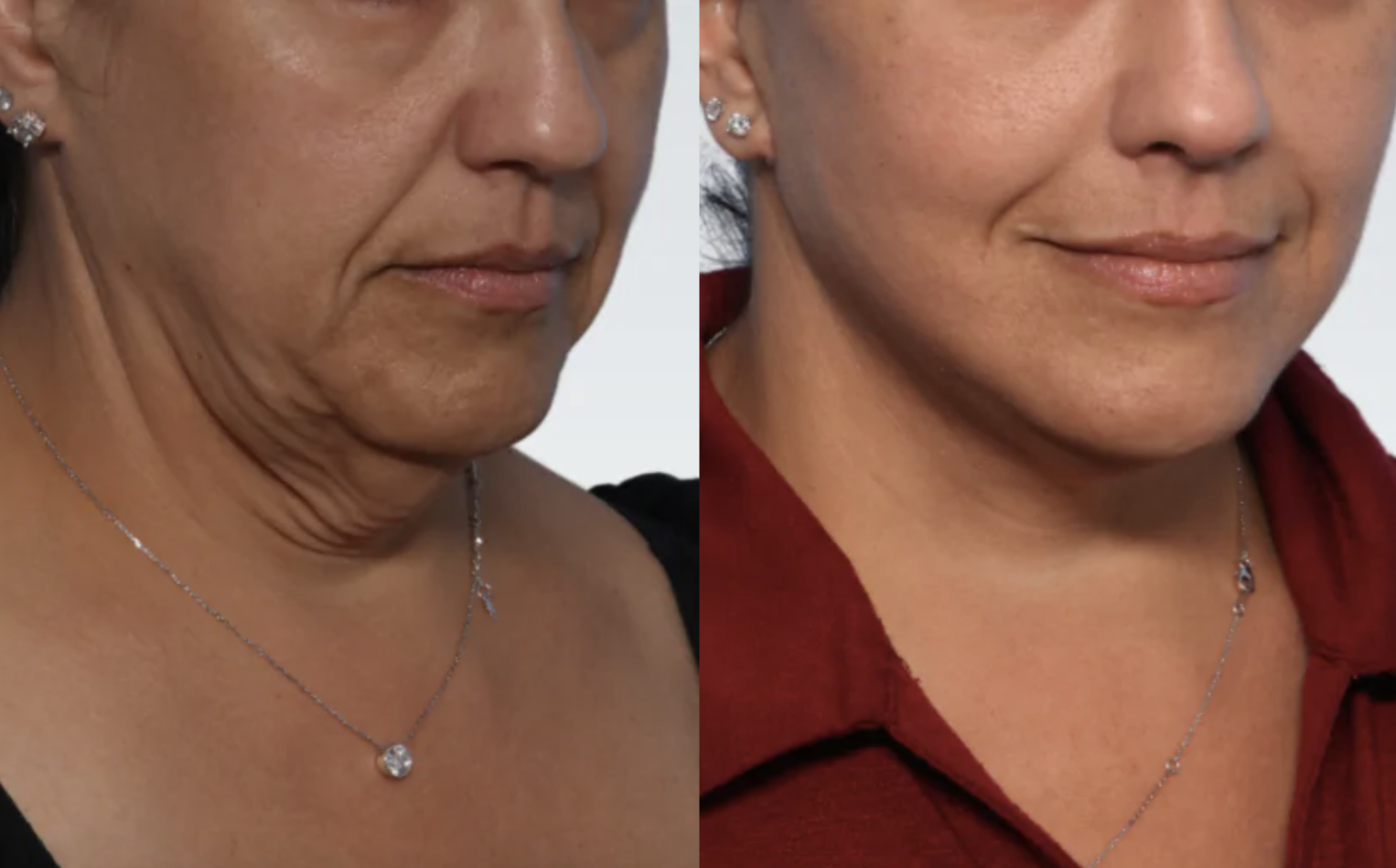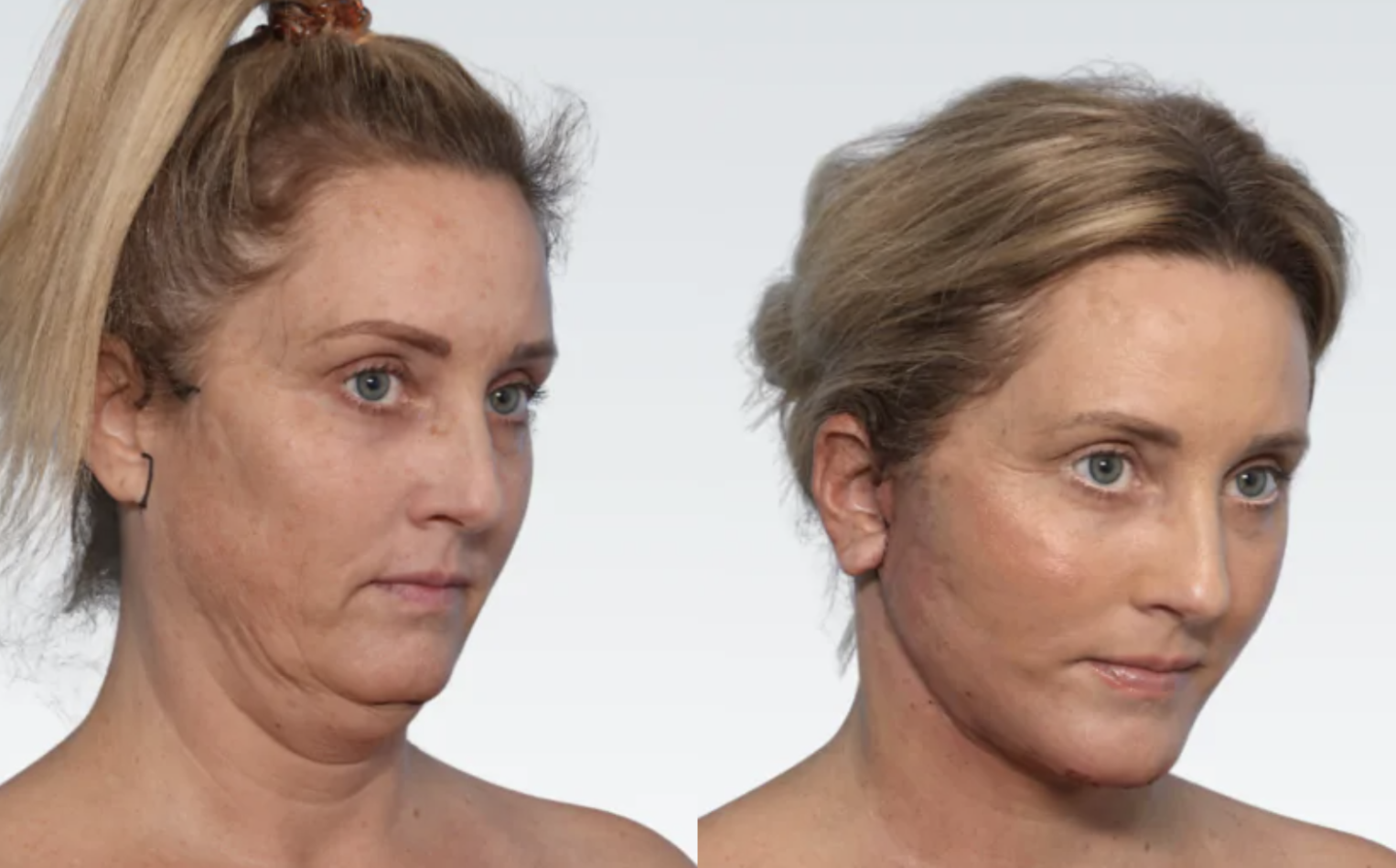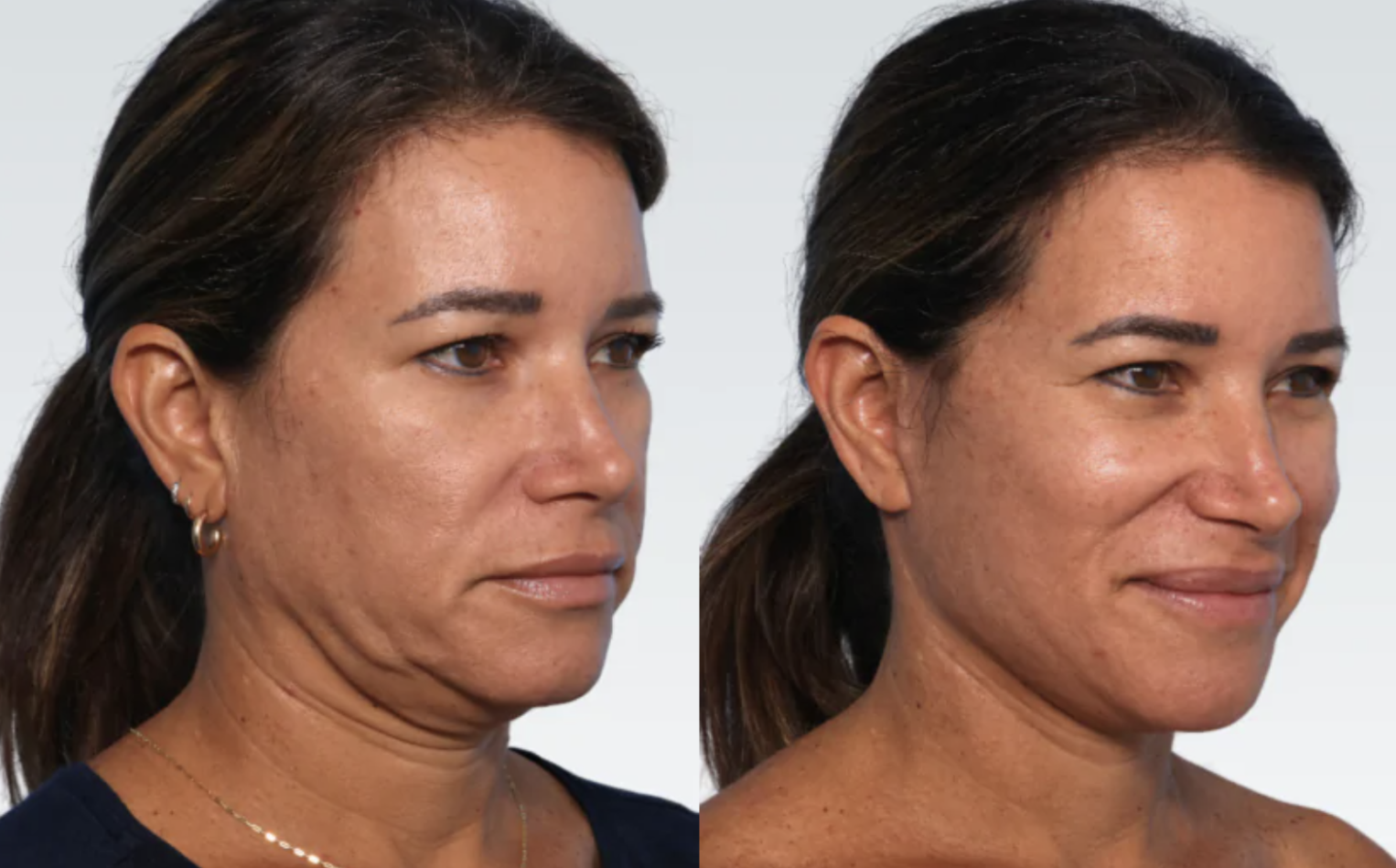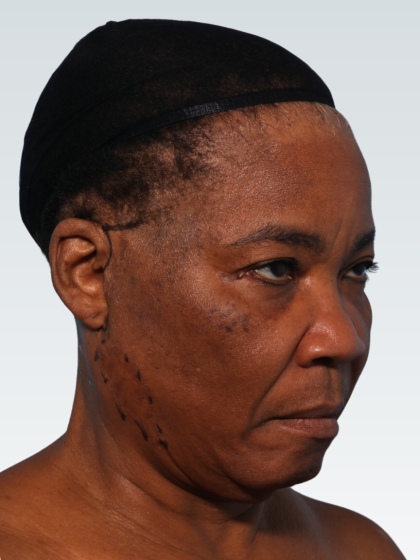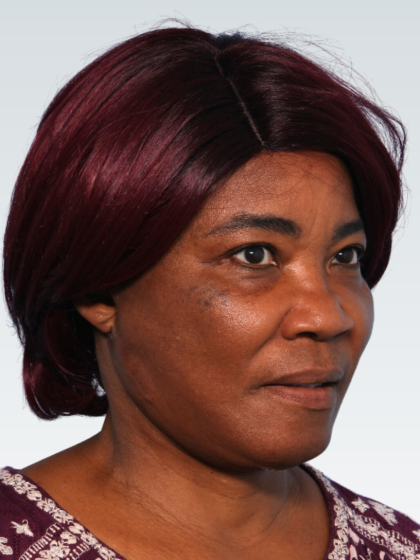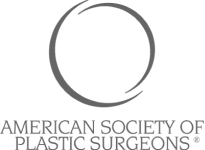Facelift
Conveniently located to serve the areas of Miami, FL

The Maercks Institute offers a range of facelift procedures tailored to different patient needs and desired levels of intervention. A central philosophy of the institute is histiocentricity, which aims to maximize natural-appearing aesthetic enhancements while minimizing downtime, swelling, and the risk of complications. The procedures range from a minimally invasive microlift to a hybrid approach, and finally to a composite deep plane facelift. These procedures are designed to improve facial aesthetics, including the neck and jawline, to provide a natural look with reduced recovery time compared to traditional facelifts.
A facelift is used to reduce the signs of aging from the face, making it one of the most popular and in-demand cosmetic surgeries in the world. If you want to look younger with a rejuvenated appearance and with a cleaner neckline, a facelift may be the perfect option for you. At The Maercks Institute in Miami, this procedure is one of our main services and one of the specialties of leading aesthetic plastic surgeon Dr. Rian Maercks.
Before and After Photos
Contents
- 1 Before and After Photos
- 2 Our facelift philosophy at The Maercks Institute
- 3 What is a facelift?
- 4 What happens to the face with age?
- 5 What is Histiocentricity?
- 6 Different Types of Facelifts
- 7 Deep Plane Facelift: Dr. Maercks’s Technique of Choice
- 8 Common Issues with Traditional Facelift and Neck Lift Techniques:
- 9 Are You a Good Candidate for a Facelift?
- 10 Consultation and Personalized Treatment Plan
- 11 Why Dr. Maercks favors the deep plane facelift technique
- 12 Facelift for Descending Skin
- 13 Facelift for Deflation
- 14 Facelift for Radial Expansion
- 15 Facelift for Neck Sagging
- 16 Ponytail Lift
- 17 Facelift or Aesthetic Facial Balancing?
- 18 How best to prepare for a facelift?
- 19 How is a facelift performed?
- 20 Recovery
- 21 24 Hour post op Facelift!
- 22 Results
- 23 See another patient journey
- 24 Why Choose Facelift, Microlift, and Neck Lift with Dr. Maercks?
- 25 Q & A with Dr. Maercks
- 26 Patient Conversation
- 27 FAQ
Our facelift philosophy at The Maercks Institute
It’s possible to get the more attractive, youthful face you want without sacrificing your natural good looks. When you choose Dr. Maercks for your facelift in Miami, you can rest assured that you’re getting focused and individually tailored care. Dr. Maercks believes in enhancing your organic beauty.
He does not conform to mainstream plastic aesthetics but is instead dedicated to the beautiful, natural human form. He will optimize your facial structure by highlighting your unique beauty through bespoke designed interventions. This means you get the more youthful appearance you want, but you will still look like yourself.
What is a facelift?
When performing a facelift, a plastic surgeon should address the entire face, including areas surrounding the jowls, cheeks, and neck. A good facelift tightens the underlying layer of muscle (called the SMAS) and removes any excess skin from the area to tighten it up. This procedure can be combined with other corrective procedures such as eyelid and/or brow rejuvenation, fat transfer to create youthful contours, and sometimes chin, nose, and/or jawline surgery.
What happens to the face with age?
As the face ages, it goes through three transformations that are often visible to the naked eye. These transformations are known as deflation, descent, and radial expansion.
- Descent: Inferior displacement of the soft tissues of the face
- Deflation: Facial fat is lost over time
- Radial expansion: Facial tissue is loosened
What is Histiocentricity?
Histiocentricity is the core principle underlying all procedures at the Maercks Institute. It emphasizes a targeted approach with minimal tissue dissection to achieve optimal results with minimal trauma.
“With application of the concept of histiocentricity, minimal tissue dissection is completed to achieve the results. This means minimal insult, minimal swelling and decreased risks of bruising and decreased risks of other complications.”
– Dr. Maercks
This philosophy leads to reduced swelling, bruising, and risk of complications, as well as minimized downtime.
“All facelift procedures are tailored using a technique called histiocentricity to achieve maximized natural-appearing aesthetic enhancements with minimal downtime.”
– Dr. Maercks
Different Types of Facelifts
The MAERCKS Microlyft
The zero recovery MAERCKS-Microlyft is the result of a decade of refinement of the MAERCKS-lift (Musculo-Aponeurotic Elevation and Retention with Check Kedge Suspension), Dr Maercks innovative facelift technique that applies his concepts of histiocentricity, a thoughtful tissue-focused approach. Using and adapting this technique to individual patient needs for over a decade has led to the development of a powerful procedure that is ultra-focused on patients’ primary concerns.
The MAERCKS Microlyft is designed to address the most common concerns of our patient population while minimizing invasiveness to deliver a completely painless solution with no downtime, no pain, and no visible scars, all the while maximizing results instead of sacrificing outcomes. This technique opens doors to patients who would not consider a surgical facelift or don’t necessarily qualify for one. The results shown here are less than 24 hours after surgery!
Most patients feel comfortable going out to dinner the same evening as their surgery! Visit our composite Deep Plane MAERCKS Lift page to see how a histiocentric approach can deliver even more profound results, with a recovery that allows patients to present socially in just 24-48 hours with complete rejuvenation and restoration of the entire face!
The MAERCKS Microlyft addresses the appearance and skin quality from the clavicle up to the lower third of the face. It cleans the neck, jawline, and lower third of the face without the dissection and insult that is conventionally necessary. Most microlyfts are completed in one hour and can be performed completely awake without anesthesia or with sedation or complete general anesthesia, depending on patient preference.
Patients may choose to add ancillary procedures that can be performed simultaneously like the MAERCKS micro-eyelift, a histiocentric blepharoplasty, additional submental lifting, genioplasty, resurfacing, and other procedures. They may also include midfacial support with the understanding that the first few days will have slightly more swelling.
The MAERCKS (Hybrid) MICRO-Volyft
The MAERCKS MICRO-Volyft essentially combines Dr. Maercks signature
Aesthetic Facial Balancing (AFB) to perform the heavy lifting that a deep
plane facelift is commonly used for in the mid and upper face. This
makes for a much simpler job for the Microlyft surgical procedure,
addressing everything from the clavicle up to the lower third of the face
and jawline. This upper face AFB and Microlyft creates a Hybrid Volyft: a combination of nonsurgical lifting/AFB and a minimal surgical neck
lift. This hybrid procedure is a match made in heaven for those with active lifestyles and no time for a break from life!
Composite Deep Plane Facelift (MAERCKS Lift)
The next step up is the Composite Deep Plane MAERCKS (Musculo
Aponeurotic Elevation and Retention with Check Kedge Suspension) Lift. This
is the ultimate blend of “subtle but profound” Maercks Magic! Implementing focused histiocentric dissection, Dr. Maercks can elevate, restore, and support the face in the true natural plane with the ligaments that naturally support the face. In this manner, a natural-appearing, harmonious, close-to-zero-downtime result is delivered, unlocking the inherent beauty of each patient.
The patients below demonstrate the IMMEDIATE, zero-to-minimal recovery associated with the MAERCKS deep plane composite facelift. With this technique, patients can be back to their routines in days to one week.
SMAS facelift
There are many different facelift techniques, and there are even more opinions on what works best. In the commoditized world of plastic surgery, many practices focus on a quick and inexpensive solution ranging from the “skin-only facelift” to the abbreviated “SMAS” (Superficial Muscular Aponeurotic System, i.e., deep structure) facelift.
Mini facelift
In a mini facelift, the lower half of the face — the jawline and jowls — are tightened, but the neck is not typically addressed. Small incisions are used to slightly pull the facial skin upwards. Shorter incisions are used (the scar stops at the earlobe), and typically only local anesthesia is used. This technique is popular due to its results and minimal recovery time.
MACS facelift
More than 80% of facelifts performed today in the U.S. are MACS (Minimal Access Cranial Suspension) lifts. This technique is a simplified technique that uses several loops of sutures to squeeze and lift the SMAS in a vertical direction. Dr. Maercks does not offer MACS facelifts because of the strange, stretched, and abnormally “pulled up” skin that can result from it. A common finding years after a MACS facelift and other vertical lift techniques is what is known as “joker lines”. Joker lines result from the lower face next to the mouth descending while the skin at the hairline is high in its vertical position. The result is a strange, drooping-then-ascending crease — much like a joker. Another issue with vertical techniques is that they are very limited in the capability of correcting neck laxity, which is usually the primary reason for seeking a facelift.
Direct SMAS facelift
Direct SMAS approaches — such as the extended SMAS lift popularized by Stuzin — offer more control of the vectors and shape of the face. When performed by a talented plastic surgeon, these techniques tend to deliver much more natural and supportive results. Dr. Maercks used these techniques early in his practice with great results.
Deep Plane Facelift: Dr. Maercks’s Technique of Choice
Although Dr. Maercks previously utilized the Direct SMAS facelift technique, he has since moved to a different concept known as a “deep plane facelift” or the “composite facelift”. He has chosen to do this for several reasons.
The principles of Dr. Maercks’ facelifting technique were elucidated by an Australian plastic surgeon named Brian Mendelson. Dr. Mendelson’s anatomic studies revealed a natural space overlying the major muscle we chew with: the masseter. This space is a safe plane of dissection that allows the facial nerve branches to be visualized and avoided. The idea of working near facial nerves can scare off surgeons from this technique; however, experienced craniofacial surgeons such as Dr. Maercks and Mendelson consider this technique much safer than blind suture placement of all other techniques that can be associated with facial nerve damage.
The major advantage of this technique is that the face is fully mobilized as a composite block instead of delaminating into several layers. The ligaments that support the face are moved at their base, which provides a much stronger, and therefore lasting, support. These ligaments are like tree trunks that branch out further and further as they reach more superficially into the face.
Moving the face under the skin is like cutting the thin end branches right below the leaves of the tree — i.e., not much support. Moving the SMAS under the skin is like grabbing the thicker branches below these twigs, lending stronger support. A deep plane facelift is essentially moving the whole tree without disrupting any branches. The natural support system is maintained and there is much less healing and recovery required. The vectors and shape of the face can be managed in a customized and natural manner.
While deep plane facelifts of the past were more aggressive and had significant complications associated with them, the modern deep plane facelift avoids many of the dangers of a conventional facelift and conveys many advantages.
The deep plane facelift that Dr. Maercks uses avoids the thinning and delamination of the face, which can result in the scarred or stretched appearance so often associated with a bad facelift. One of the other advantages is that the deep ligaments are re-suspended, and there is no tension on the skin. This results in superior treatment of the central face and an extremely natural-looking, supported face.
Common Issues with Traditional Facelift and Neck Lift Techniques:
Many patients seeking facial rejuvenation with traditional facelifts or neck lifts encounter limitations with standard methods, including:
- Overly Tight, Artificial Appearance: Traditional facelifts often focus on pulling the skin tight rather than lifting underlying structures. This can lead to an unnatural, “windblown” look that detracts from a natural appearance.
- Significant Downtime and Visible Scarring: Many facelifts require large incisions, often resulting in visible scars around the ears or hairline, prolonged recovery times, and significant bruising and swelling.
- Limited Neck Rejuvenation: Standard facelifts may not adequately address the neck, leading to a disconnection between the smooth appearance of the face and the visible aging signs in the neck.
How Dr. Maercks Resolves These Issues with Advanced Facelift, Microlift, and Neck Lift Techniques
Dr. Maercks’s specialized techniques go beyond traditional methods, offering a natural, contoured look with minimal scarring and downtime.
- Craniofacial and Reconstructive Expertise: With advanced training in craniofacial and reconstructive surgery, Dr. Maercks applies an anatomical approach to facial rejuvenation, lifting and sculpting the deeper facial layers for a refined, natural look while avoiding unnecessary trauma that causes recovery.
- Natural Contours and Minimal Skin Tension: Dr. Maercks’s techniques prioritize natural contouring rather than just tightening the skin. By repositioning the underlying muscle and connective tissue, he creates soft, natural results that avoid the overly tight look of standard facelifts. Dr. Maercks customizes multiple different directions and strengths of the repositioning to the individual patient.
- Customizable Microlift for Subtle Refreshment: For patients looking for a more subtle, refreshed appearance, Dr. Maercks’s Microlift offers a minimally invasive alternative to a full facelift. The Microlift rejuvenates the lower face with minimal downtime and scarring.
- Integrated Neck Lift for Seamless Rejuvenation: Unlike many standard facelifts, Dr. Maercks’s approach includes an integrated neck lift option. This technique sculpts and smooths the neck, enhancing the natural harmony between the face and neck for a complete rejuvenation. All without the recovery commonly associated with facelifts.
Are You a Good Candidate for a Facelift?
If you’re interested in undergoing a facelift in Miami, you may be an excellent candidate. The first step is to schedule a consultation to see if it’s the right procedure for your needs. Dr. Maercks may determine that a mini facelift or a non-surgical procedure is better for you.
In general, those who make good candidates for a facelift are those who:
- Are non-smokers in good health
- Have enough sagging/excess skin for the surgery to be beneficial
- Are in their 40s to 70s
- Have realistic expectations for the procedure
Consultation and Personalized Treatment Plan
One-on-One Consultation: Your rejuvenation journey with Dr. Maercks begins with a detailed consultation to discuss your goals, assess your facial structure, and explore the best options for achieving a refreshed, natural look.
Comprehensive Facial Analysis: Dr. Maercks takes a holistic approach, assessing each feature and how it contributes to the overall balance of the face and neck. This allows him to create a personalized treatment plan that enhances natural proportions.
Anesthesia Options: Facelifts, Microlifts, and neck lifts can be performed with local or general anesthesia, depending on the procedure’s extent, to ensure maximum comfort.
Schedule A Consultation
Why Dr. Maercks favors the deep plane facelift technique
Dr. Maercks typically selects the deep plane facelift technique over other methods such as the mini facelift or others. He chooses the deep plane technique to restore a supported youthful appearance when there is extensive neck and/or facial laxity that cannot be addressed non-surgically. When a surgical facelift is needed, Dr. Maercks leverages the power of fat transfer to rebuild youthful volume around the eyes, lips, temples, and forehead. He also commonly performs a browpexy and four-lid blepharoplasty to ensure the entire face is harmoniously rejuvenated. To achieve a beautiful neckline, he incorporates a platysmas kite flap that lifts and supports the neck. The sum of these procedures produces the natural-looking MAERCKS lift (Musculo-Aponeurotic Elevation and Retention Check Kedge Suspension lift).
Facelift for Descending Skin
Over time, the underlying tissues and the skin of the face will descend. This change is often noticeable first in the mid-face where the cheek starts to descend, and creates two different effects: either a hollow spot forms as fat as the cheek descends, or jowls appear as the tissues of the face descend down and forward. The muscle that starts in the lower face and continues to run down the neck is referred to as the platysma. As the body ages and this muscle descends, jowls are often the result.
A jowl is the muscle’s front end as it sags. If the muscle sags in the neck, it may create bands around the front. A facelift should elevate the cheek back to its original position. This restores fullness to the spot between the lower eyelid and the cheek. Many facelifts fail to account for this change, while we believe it is a huge part of restoring the natural, youthful look and feel of a face. A thorough facelift will re-position this muscle to its natural position to remove jowls. Along with the facelift, fat transfers may be used to further lift and balance the cheeks and create a younger appearance.
Facelift for Deflation
Patients who notice hollowness in some areas as the skin ages may be noticing deflation. Deflation is usually due to the descent of facial fat or a noticeable loss of fat volume. Most patients notice this problem first in the area directly underneath the cheek. To correct for deflation, a facelift should account for these hollow areas created by a shift in fat volume from aging. During the procedure, volume is replenished by re-positioning the deep tissues of the face, either by an autologous fat transfer or simple re-positioning of the fat.
Facelift for Radial Expansion
Radial expansion is noticeable as an outward push in some facial areas that is common during aging. This creates a loss of the definition of the jawline and is most noticeable in the jawbone’s lower border and the jowls. Radial expansion is a result of facial-retaining ligaments weakening over time. These tissues separate from deeper tissues as they become weaker and may be a very difficult problem to correct, even with surgery. During a facelift to correct radial expansion, deep tissues are elevated and secured to recreate the original, youthful-looking jawline.
Facelift for Neck Sagging
The neck is one of the first places patients notice the effects of aging, as it often begins to sag over time. Muscle descent, increasing skin laxity, and inflation are all causes of neck sagging and should be addressed accordingly by your plastic surgeon during a facelift. These changes are caused as the platysma muscle loosens over time. This causes a fullness right around the jaw, which may create jowls and require a platysmaplasty (tightening of this muscle). When fat accumulates right under the chin, the neck may need to be sculpted during a facelift to maintain a natural, youthful appearance. Taking too much fat out of this area may leave the neck looking skeletonized and make structures of the neck visible. When the neck loses elasticity and becomes lax, there may be extra skin over the neck.
A facelift can tighten the skin and muscles and remove the excess skin but does not address the issue of skin laxity and how to fix it. This may require certain non-invasive skin tightening procedures after a facelift. This is a common cause of the dissatisfaction some patients have with the neck area after the procedure. Patients should note that a mini facelift does not address sagging neck skin.
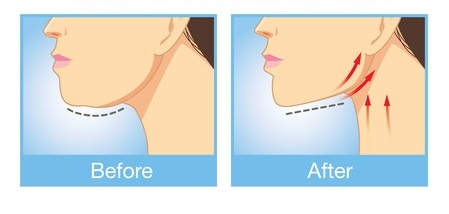
Composite Facelift Procedure
Ponytail Lift
What is the ponytail lift technique?
One of the main problems with a traditional facelift is that it approaches the face in sections rather than as a whole. The ponytail lift is an alternative that provides clients with holistic anti-aging results, combating sagging, jowling, and drooping comprehensively. A ponytail lift may include an eyelid lift, a jowl lift, skin tightening, and more.
How does it differ from a traditional facelift?
During a conventional facelift, your plastic surgeon will create incisions within the folds of the ears stretching into the hairline. Ponytail lift incisions are made endoscopically and are thus smaller and more easily hidden. A ponytail lift works best for younger Miami patients who are just beginning to see the signs of aging, such as sagging cheeks and a loss of facial fat volume.
The ponytail lift is known for delivering a natural appearance after surgery. You will never see an unsightly windblown or pulled aesthetic, making it the procedure of choice for many image-conscious clients who desire authenticity in their appearance.
What are the benefits of a Ponytail Lift?
- Incisions are hidden behind the ears where they are inconspicuous
- Longer-lasting results than with a traditional facelift
- Natural-looking results that don’t look windswept or pulled
- Preserves facial spontaneity and your unique expressions
- Minimally invasive
Facelift or Aesthetic Facial Balancing?
Over time and as the body ages, the face’s layers may loosen and separate. These layers include muscle, fat, and skin. A successful facelift will fully rejuvenate the neck and the face by properly addressing these issues when necessary. Neck laxity is the main determinant as to whether Dr. Maercks will recommend a formal facelift, a mini facelift, or one of his customized Aesthetic Facial Balancing techniques to deliver a naturally lifted appearance without surgery.
How best to prepare for a facelift?
The first step on your way to a facelift is to have a consultation with Dr. Maercks at his Miami surgical center. Once he has determined that you’re a good candidate for a facelift, you’ll need to stop taking any anti-inflammatory medications at least two weeks before surgery. You’ll also need to avoid alcohol starting five days before surgery to decrease bruising and swelling.
How is a facelift performed?
As mentioned above, Dr. Maercks typically performs a facelift using the deep plane facelift technique. Typically, the patient is placed under anesthesia before the procedure begins. The incision is hidden in and around the ear. Fat is then re-distributed or sculpted from the neck, face, and jowls, and tissue is re-positioned as muscles are lifted and re-shaped. A more in-depth facelift may require an additional incision right under the neck.
The incisions are closed with either skin adhesives or sutures after the procedure is complete. Dr. Maercks may use any of the following techniques:
- Soft tissue augmentation
- Wrinkle reduction
- Resurfacing techniques
- Facial fat grafting
The Facelift, Microlift, and Neck Lift Procedure
Neck Lift for Comprehensive Rejuvenation: Dr. Maercks’s neck lift technique sculpts and tightens the neck, reducing sagging and improving jawline definition. This integrated approach ensures a seamless look between the face and neck, addressing concerns like loose skin or a double chin.
Precision Incision Placement: Dr. Maercks strategically places incisions along natural creases around the ears and hairline to keep scars discreet. His refined technique minimizes visible scarring while allowing access to underlying structures for optimal lifting.
Deep Tissue Repositioning for Lasting Results: Unlike traditional facelifts, Dr. Maercks’s approach involves lifting and tightening the deeper facial muscles and connective tissue rather than simply pulling the skin. This technique creates a natural, long-lasting lift with a more youthful contour.
Microlift for Subtle Lower Face Rejuvenation: For patients seeking a softer, less invasive lift, Dr. Maercks offers the Microlift. This minimally invasive procedure focuses on the lower face and jawline, reducing sagging and refreshing the face without the need for a full facelift.
Recovery
Recovery from a facelift at Dr. Maercks’s office is quick, and patients enjoy the following advantages:
- Minimized Downtime: Dr. Maercks’s precise techniques reduce trauma to surrounding tissues, allowing for quicker healing. Most patients experience minimal bruising and swelling, allowing them to return to normal activities sooner than with traditional facelifts.
- Personalized Aftercare: Dr. Maercks provides individualized aftercare instructions to support optimal recovery and long-term results. His approach includes specific guidance on activity levels, skincare, and lifestyle tips to promote healing.
- Less Tissue Trauma for Smoother Recovery: By using small, strategically placed incisions and avoiding unnecessary skin tension, Dr. Maercks minimizes tissue trauma, leading to a more comfortable recovery with minimal discomfort.
A facelift is an outpatient procedure, and most patients return home on the day of surgery. We offer overnight stays with nursing care at The Maercks Institute in Miami for patients who prefer this convenience. The first night should be spent in bed, with activity at a minimal level. Patients can resume a normal diet.
Facial and neck swelling is reduced by keeping the head elevated, and patients should ice for the first night to control swelling. After surgery, your face will be wrapped in a bandage to minimize pain and keep the skin flat. Most patients can control pain with Tylenol, but additional pain medication may be given as required or needed.
You can expect to return to normal activity levels two weeks after a facelift. Within the first three weeks, close to 70% of the expected swelling is resolved, although it may take 2 to 3 months for the swelling to go away completely. A mini facelift requires less recovery time than a traditional facelift.
You will see Dr. Maercks the following day to remove the bandages. Some bruising on the neck is normal, and no bandage is typically necessary after the first morning. We offer in-office hair shampooing for the first morning. On day five after surgery, the stitches on the chin and ear are removed, and you will be able to resume regular hair washing and showering.
24 Hour post op Facelift!
Results
The final desired results of any facelift may not be completely noticeable for several months after the procedure. Patients typically report looking and feeling ten years younger after their Miami facelift from Maercks, and results can last as long as a decade or more. Facial rejuvenation surgery has extremely high satisfaction results, and most patients love what they see.
We are also proud of the results our patients see after a facelift regarding scarring. All incision marks are hidden in natural creases of the skin and behind the hair. All incisions are closed without tension to reduce scarring, and closure is always meticulous and tension-free to give you the best results after your procedure. We know you want the most natural-looking appearance possible after surgery, and Dr. Maercks does his best to hide the incisions where no one will see them.
Natural and Long-Lasting Results
- Balanced, Youthful Appearance: Dr. Maercks’s facelift and Microlift techniques offer a naturally youthful look, enhancing facial contours without creating an overly tight appearance. The results are soft, balanced, and rejuvenated.
- Long-Lasting Lift and Support: By focusing on the deeper structures of the face, Dr. Maercks’s techniques provide a stable foundation that supports a long-lasting lift, reducing the likelihood of needing future revisions.
- Harmonized Face and Neck Rejuvenation: With an integrated neck lift option, Dr. Maercks’s approach rejuvenates both the face and neck, creating a cohesive look that feels natural. The neck lift also enhances jawline definition, addressing concerns like sagging skin and double chin for an all-encompassing transformation.
See another patient journey
Why Choose Facelift, Microlift, and Neck Lift with Dr. Maercks?
- Expertise in Craniofacial and Reconstructive Surgery: Dr. Maercks’s extensive background in craniofacial and reconstructive surgery provides a deep understanding of facial anatomy, ensuring a precise and natural result that enhances individual features.
- Customized Approach for Each Patient: Dr. Maercks tailors each procedure to meet the unique goals and anatomy of his patients, creating a personalized approach that aligns with each individual’s vision of rejuvenation.
- Natural, Lasting Results with Deep Tissue Repositioning: By focusing on the deeper structures of the face and neck, Dr. Maercks achieves results that are both natural and durable. His methods create a stable foundation that reduces the need for frequent touch-ups.
- Refinement and Revision Expertise: For patients who may have had unsatisfactory facelifts elsewhere, Dr. Maercks’s revision skills allow him to refine and correct previous work, achieving a more balanced and natural appearance.

At The Maercks Institute in Miami, we’re proud of our focus on customizing each treatment to the individual patient. After a facelift or mini facelift from Dr. Maercks, patients never look stretched or pulled, and he uses a personalized signature technique to ensure that the effects of aging are minimized, yielding a natural-looking result. The goal is a balanced, natural-looking face and a well-defined, youthful neck. Not only is face surgery one of our main services; but Dr. Maercks will also formulate the ideal treatment for your specific goals. As a board-certified cosmetic, plastic, and reconstructive surgery specialist with an artist’s eye, he will leverage your unique beauty and use experienced judgment, attention to detail, and artistic vision to accomplish beautiful, natural-looking results. Dr. Maercks’s undergraduate training in fine arts and philosophy created the framework through which he explores the world of plastic surgery, and he has been changing the lives of patients since opening his practice in 2009. He elevates the standard of patient care and safety through his work as medical director at The Maercks Institute, and his approach to both surgical and non-surgical aesthetic procedures has garnered him international recognition from surgeons and patients alike.
If you’re interested in scheduling a consultation for a facelift in Miami, please contact our office today.
Q & A with Dr. Maercks
Patient Conversation
FAQ
How much does a facelift cost in Miami?
As with most cosmetic surgeries, the cost of the procedure depends entirely on the patient and the nature of the surgery. The cost of a facelift at The Maercks Institute in Miami is typically $15,000 to $50,000, depending on if the patient will be receiving additional procedures along with the facelift. All fees include anesthesia and operating room costs, but please note that this number is a general estimate and may be different for every patient.
What is a non-surgical facelift?
There are many non-surgical options available at The Maercks Institute in Miami, such as Aesthetic Facial Balancing which delivers beautiful facial transformations that resemble facelift results, but that don’t require surgery. This is often more affordable and takes much less recovery time. Dr. Maercks usually opts for non-surgical measures such as these for patients who do not have significant neck findings. Significant neck laxity is a good indication to jump ahead to a surgical facelift.
What is a mini facelift?
A mini facelift addresses the lower half of the face. It uses shorter incisions — which means a smaller scar — and requires less cost and recovery time. A mini facelift is best for those with mild to moderate jowling or sagging skin on the face. Results from a mini facelift last 7 to 15 years, depending on the patient.
What risks are associated with a facelift?
As with any surgery, there are risks associated with a facelift. However, these risks can be controlled and minimized by a proper home care routine, which we will provide you with. Although rare, there is a risk after a facelift for a hematoma, which is treated by draining in the doctor’s office. Facelifts are not typically performed on active smokers, because nicotine may reduce the skin’s blood flow and negate the results of the surgery.
